#pochampally handloom silk saree
Explore tagged Tumblr posts
Text

Pochampally Handloom Silk Saree | Tapathi.com
Discover the classic style and fine workmanship of Pochampally handloom silk saree available at Tapathi.com. Shop today to appreciate the elegance of tradition.
0 notes
Text
Drape Yourself in Elegance: Samyakk Ikkat Sarees
Introduction:
When you think of ikat — intricate diamond-shaped patterns, curved scrolls and paisley designs come to mind. Do you know, what seems like printed designs on fabric is actually a complex weaving style that uses specially dyed threads to develop a pattern on the fabric as the weaver weaves along? Even though it is a tie-dye textile art, ikat has its own flavour.
If you really go back in history, ikat is not India’s indigenous textile art. It is also called as ikkat or ikhat. Actually, textile historians are still trying to figure out ikat’s place of origin, since this textile art can be seen far and wide. These sarees, characterized by their mesmerizing resist-dyeing technique, embody a captivating confluence of tradition and style. This comprehensive exploration delves into the world of ikat sarees pochampally, highlighting their diverse forms, rich history, and the artistry that continues to enthral saree connoisseurs worldwide.

Unveiling the Essence of Ikat: A Journey Through Resist-Dyeing
The word “ikat” itself originates from the Indonesian word “mengikat,” meaning “to bind.” This aptly captures the essence of the resist-dyeing technique that breathes life into these sarees. Skilled artisans meticulously tie and dye individual threads before the weaving process begins. The laborious nature of this technique imbues each ikat saree with a unique story, a testament to the dedication and artistry of the weavers.
Pochampally and Pattu: A Celebration of Ikat’s Regional Diversity
The beauty of ikat sarees lies in their regional variations, each boasting distinct styles and characteristics. Among the most celebrated are the Pochampally Ikat sarees from Telangana. Famed for their intricate geometric patterns and vibrant hues, Pochampally sarees are a visual feast, often featuring bold colors like red, green, and yellow. In contrast, Pattu Ikat sarees from Odisha showcase a softer, more flowing aesthetic.
Exploring the Spectrum of Ikat: From Modern Interpretations to Timeless Classics
The versatility of ikat sarees is one of their most captivating features. They seamlessly adapt to various styles and occasions, catering to diverse preferences. Ikat half sarees, a contemporary twist on tradition, offer a youthful and elegant alternative to the full saree. These sarees, typically draped from the waist down, are paired with complementary lehengas or skirts, creating a modern yet sophisticated ensemble. For those seeking a more subtle nod to Ikat’s beauty, ikat print sarees offer a modern interpretation of the classic design. These sarees feature printed ikat patterns, often on a variety of fabrics, making them ideal for everyday wear or a fusion look.

A Treasure Trove of Ikat Designs: Unveiling the Weavers’ Canvas
Ikat sarees offer an endless array of designs to suit every taste and preference. Ikat handloom sarees bear the distinct imprint of skilled artisans, each thread imbued with the weaver’s story. Ikat border sarees add a touch of vibrancy and elegance with their contrasting borders. These borders often feature geometric patterns or floral motifs, framing the central design of the saree and adding a touch of visual interest. For those seeking a touch of luxury, double ikat sarees represent the pinnacle of craftsmanship.
The saree is one garment that definitely flatters every woman — Sabyasachi Mukherjee
Affordable Elegance: Ikat Sarees for Every Budget
The beauty of ikat sarees is not just limited to luxury; they are also accessible to a wide range of budgets. Ikat pattu sarees offer the chance to experience the magic of ikat at an affordable price. These sarees, often crafted from silk blends or high-quality cotton, showcase the essence of ikat without breaking the bank. Pure Ikat cotton sarees, with their lightweight comfort and breathable fabric, are ideal for everyday wear. Often featuring geometric or floral patterns in vibrant colors, these sarees are a perfect choice for adding a touch of cultural flair to casual outings. Sambalpuri ikat sarees, a vibrant expression of Odisha’s heritage, are another budget-friendly option. These sarees, featuring intricate geometric patterns and vibrant colors, are available at various price points, making them a popular choice for those seeking a unique and affordable ikat experience.

Styling Ikat Sarees: A Guide to Timeless Beauty
The magic of ikat sarees lies not only in their intricate designs but also in the way they are styled. Ikat saree blouse designs play a crucial role in complementing the saree’s motifs and colors. A well-chosen blouse can elevate the saree’s look, adding a touch of personality and elegance. For ikat silk saree blouse designs, rich embellishments like embroidery, zardozi work, or intricate beading can create a regal look. Conversely, for ikat cotton sarees, simpler blouses with contrasting
colors or subtle embroidery can add a touch of sophistication without overpowering the saree’s inherent beauty. Ikat half saree blouse designs offer even more creative freedom. Here, experimentation with bold colors, patterns, and necklines can create a truly unique and eye-catching ensemble.
When an Indian girl wears a saree, the world stops to admire her grace! — Samyakk
A Timeless Legacy: Unveiling the History of Ikat Sarees
The origins of ikat can be traced back centuries, with evidence suggesting its practice as early as the 2nd century CE. Ikat saree origin remains shrouded in some mystery, but archaeological finds and historical records point to its presence in Southeast Asia and various parts of India. Over time, the art of ikat spread across different regions, each community adding its unique touch to the art form. Today, we find stunning ikat sarees Odisha, ikat sarees Bangalore, and ikkat sarees Hyderabad, each showcasing the distinct cultural influences of their respective weaving centers.

Beyond Borders: The Global Appeal of Ikat Sarees
The allure of ikat sarees has transcended geographical boundaries, captivating fashion enthusiasts worldwide. The internet has played a crucial role in this global phenomenon. Ikat sarees online offer a convenient platform for international customers to discover the vast array of designs and styles available. From traditional handloom creations to contemporary interpretations, online retailers cater to diverse tastes and budgets. Websites like Samyakk showcase the exquisite craftsmanship of Indian weavers to a global audience.
A Celebration of Artisanship: The Future of Ikat Sarees
Despite the challenges posed by mass production, ikat sarees continue to thrive due to their inherent value and cultural significance. The ikkat handloom saree industry provides a sustainable livelihood for generations of weavers, preserving this age-old tradition. Organizations dedicated to promoting ikkat cotton sarees wholesale price and sambalpuri ikat saree production empower local communities and ensure the continued production of these exquisite textiles.
The Final Word: Ikat Sarees — A Timeless Treasure
Ikat sarees, with their rich history, intricate craftsmanship, and timeless elegance, continue to captivate hearts and inspire minds. Each saree is a testament to the enduring legacy of Indian textile heritage, a masterpiece woven with passion and skill. Whether adorning a traditional occasion or adding a touch of elegance to contemporary style, ikat sarees embody the perfect fusion of tradition and modernity.
Looking to Explore the World of Ikat Sarees?
Here’s a quick guide to help you on your journey:
Discover your style: Explore the different types of ikat sarees — Pochampally, Pattu, ikat cotton sarees, ikat half sarees, and more.
Set a budget: Ikat sarees are available at various price points, from ikat pattu sarees below 5000 to luxurious double ikat sarees.
Explore online retailers: Numerous websites like Samyakk offer a wide variety of ikat sarees, including ikat sarees online and sambalpuri ikat saree retailers.
Find the perfect blouse: Complement your chosen saree with a stylish blouse design, considering ikat silk saree blouse designs or simpler options for cotton sarees.
With a little exploration, you’re sure to find the perfect ikat saree to suit your taste and budget. So, dive into the world of ikat and discover the timeless elegance that awaits!
A saree silently empowers you — Samyakk
People Also Ask:
1. What does “ikat” mean? A: The word “ikat” originates from the Indonesian word “mengikat,” meaning “to bind.” This aptly describes the resist-dyeing technique used to create the intricate patterns on ikat sarees.
2. What are the different types of ikat sarees?
A: There are many types of ikat sarees, each named after the region where they are woven. Some popular ones include:
Pochampally Ikat Sarees: Famed for their vibrant geometric patterns.
Pattu Ikat Sarees: Known for their softer, more flowing aesthetic and nature-inspired motifs.
Sambalpuri Ikat Sarees: A vibrant expression of Odisha’s heritage, featuring intricate geometric patterns.
Ikat Cotton Sarees: Lightweight and comfortable, ideal for everyday wear.
Ikat Silk Sarees: Exude a luxurious feel with their rich sheen and intricate patterns.
3. Where can I buy ikat sarees online? A: Numerous websites like Samyakk offer ikat sarees online. Popular options include websites dedicated to specific regions like Ikkath And Patola, as well as broader online retailers featuring a variety of styles.
4. How can I style an ikat saree? A: The beauty of ikat sarees lies in their versatility. You can pair them with traditional blouses featuring rich embellishments like embroidery or zardozi work for a formal look. Simpler blouses with contrasting colors or subtle embroidery complement cotton ikat sarees for a more casual vibe. Ikat half sarees offer even more creative freedom when it comes to blouse designs.
5. How do I care for my ikat saree? A: Gentle handwashing with cold water is recommended. For delicate ikat silk sarees, consider professional dry cleaning. Avoid direct sunlight when drying and store your sarees in a cool, dry place away from moisture.
By exploring these questions and delving deeper into the world of ikat sarees, you can embark on a journey of cultural appreciation and discover the timeless elegance that awaits.
Conclusion: Ikat Sarees — A Timeless Treasure Woven in Tradition
Ikat sarees blend tradition and style, showcasing Indian weavers’ artistry. These captivating designs celebrate a rich, timeless heritage. Whether you seek the vibrant geometric patterns of Pochampally or the softer elegance of Pattu, the world of ikat offers something for every taste and occasion.
The affordability of ikat sarees, with options ranging from ikat cotton sarees below 5000 to luxurious double ikats, makes them accessible to a wide range of saree connoisseurs. The convenience of ikat sarees online further widens the reach of these exquisite textiles, allowing global fashion enthusiasts to discover the magic of ikat. Choose handloom ikat sarees. Support artisans. Preserve tradition. Inspire the future.
#Ikat sarees#Pochampally Ikat sarees#Pattu Ikat sarees#Ikat cotton sarees#Ikat silk sarees#Sambalpuri Ikat sarees#Double Ikat sarees#Ikat saree blouse designs#Buy Ikat sarees online#Ikat saree price#How to style Ikat sarees#Ikat saree care#Indian handloom sarees#ikkat patta saree#where to buy ikkat sarees#ikkat saree drape style#how to identify original ikkat saree
0 notes
Photo
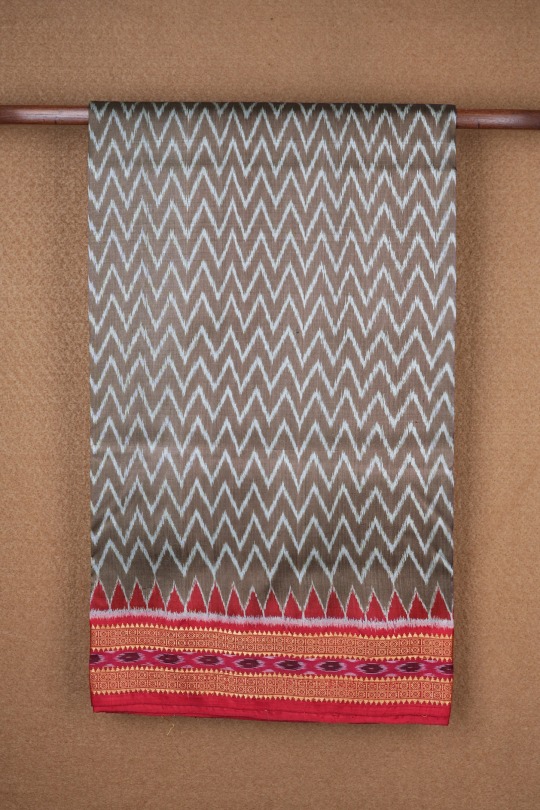
Pochampally Silk Sarees | Ikat Designer Silk Sarees | Contrast Border Sarees - Sundari Silks
This handwoven Pochampally Silk Saree in dusty brown has chevron design in body with contrast border in red. The border and pallu houses allover design. It comes without blouse piece.
Shop from: sundarisilks.com/collections/pochampally-silks
Visit our website: sundarisilks.com/
#sundari silks#pochampally sarees#ikat designer sarees#contrast border sarees#pochampally sarees online#pochampally sarees online shopping#pochampally silk#Ikkat sarees#sarees for wedding#pochampally silk sarees#Ikkat silk sarees#handloom sarees
0 notes
Text
Traditional Sarees: A Timeless Elegance for Every Occasion
Sarees have been an integral part of Indian culture for centuries. They represent elegance, tradition, and grace, making them the preferred choice for women during festive celebrations, weddings, and special occasions. At Vastradi.com, we bring you an exquisite collection of traditional sarees that blend heritage with contemporary fashion.
Types of Traditional Sarees
1. Banarasi Sarees
Originating from Varanasi, Banarasi sarees are known for their rich silk fabric and intricate gold and silver zari work. These sarees are perfect for weddings and festive occasions.
2. Kanjeevaram Sarees
Kanjeevaram or Kanchipuram sarees hail from Tamil Nadu and are famous for their durability, luxurious silk, and vibrant colors with temple borders.
3. Chanderi Sarees
Chanderi sarees from Madhya Pradesh are lightweight, elegant, and feature unique motifs like peacocks and florals, making them ideal for casual and formal wear.
4. Patola Sarees
Handwoven in Gujarat, Patola sarees are double-ikat sarees known for their geometric designs and bright colors.
5. Bandhani Sarees
A specialty of Rajasthan and Gujarat, Bandhani sarees are crafted using the traditional tie-dye technique, offering vibrant colors and intricate patterns.
6. Paithani Sarees
Paithani sarees from Maharashtra feature handwoven silk with intricate peacock and lotus motifs, often accentuated with gold zari borders.
7. Sambalpuri Sarees
Sambalpuri sarees from Odisha are handwoven using a unique tie-dye method and are recognized for their detailed craftsmanship.
8. Tant Sarees
Tant sarees from West Bengal are made of fine cotton, making them comfortable and breathable, perfect for daily wear.
9. Pochampally Sarees
From Telangana, these sarees showcase beautiful ikat designs woven with a mix of silk and cotton.
10. Muga Silk Sarees
Exclusive to Assam, Muga silk sarees have a natural golden sheen and are known for their durability and elegance.
How to Style Traditional Sarees
Pair with traditional jewelry like jhumkas, temple necklaces, and bangles.
Opt for modern blouse designs to add a contemporary touch.
Drape your saree in different styles like Nivi, Bengali, or Gujarati drapes.
Complement your look with ethnic footwear such as juttis or mojris.
Why Choose Vastradi for Traditional Sarees?
Authentic Handloom Sarees with intricate craftsmanship.
Wide Range of Collections featuring sarees from all across India.
Affordable Pricing & Discounts on exclusive designs.
Worldwide Shipping to deliver elegance at your doorstep.
Explore our latest collection of traditional sarees online at Vastradi.com and embrace the timeless charm of Indian ethnic wear!
Traditional sarees, Banarasi sarees online, Kanjeevaram silk sarees, Buy sarees online India, Handloom sarees, Wedding sarees, Festive sarees, Pure silk sarees, Best online saree store, Ethnic wear for women.
0 notes
Text
Discover the Latest Handloom Sarees: Timeless Elegance Redefined
Indigenous to this great country and carrying the fine and beautiful craft as well as rich traditions that have been flourishing here for generations, the latest handloom sarees were symbols of Indian culture throughout ages. However, they have now caught the trend of modern styles and have been redesigned in fresh, trendier forms keeping intact their traditional weave. This revival is going to redefine timeless elegance for current portfolios, thus making it a requisite must-have in every modern-day closet.
The Resurgence of Handloom Sarees
The fashion industry finally bows down to sustainable and ethically sound production in the field of clothing. Examples of contemporary handloom sarees include Tapathi, who design those classic attires with the least possible impact on the environment. Each saree narrates the story of the weaver's toil, artistry, and culture within a specific region. Tapathi simply oozes through this revived acknowledgment by enriching the collections with the perfect convergence of age-old tradition and disruptively modern aesthetics.
Exploring the Latest Handloom Saree Collection
There are very promising saree collections by leading brands that beautifully blend tradition with modernism. Among these collections are:
Kuppadam Pattu Sarees
The hallmark of these sarees is the unique method of weaving. Expensive, exotic designs and vibrant colors make them perfect for festival wear.
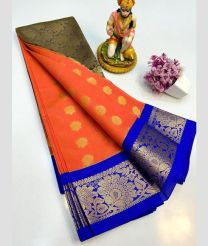
Kanchi Pattu Sarees
These sarees are highly famous for their rich silk with intricate zari work from the place called Kanchipuram, so they truly define the opulence and grace.
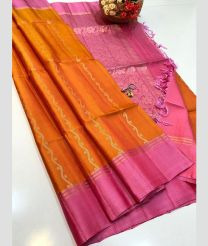
Uppada Pattu Sarees
Lightweight yet stylish, these excellent qualities make Uppada Sarees the preferred choice for all occasions-whether casual or formal-as they are made out of fine silk and complex jamdani weaving.
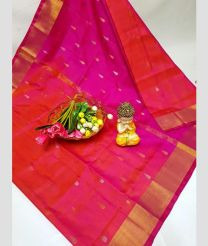
Pochampally Ikkat Pure Silk Sarees
Featuring geometric designs with multi-hued colors, these sarees stand for ikkat dyeing, extremely traditional in a contemporary fangled aspect.
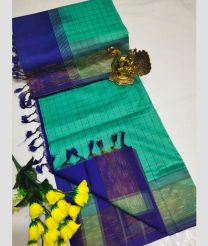
Gadwal Pattu Sarees
Usually composed of a mixture of cotton with silk, the Gadwal sarees are famously light in texture and sport a contrasting border, making them very versatile for many occasions.

Paithani
These originated from Maharashtra and are generally associated with beaked forms and lively colors that symbolize both prosperity and tradition.
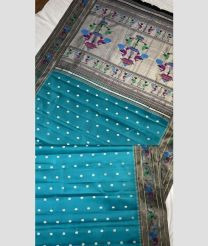
Chanderi Silk Sarees
Hailing from Madhya Pradesh, these are thin yet not easily worn and covered by traditional motifs decking.

Linen sarees modernize women
They give comfort along with classiness in understated designs that are fit to wear in the office and go into parties.
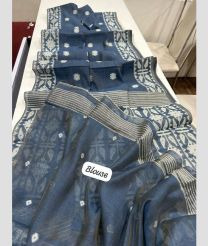
Banarasi Sarees
The very synonym of luxury. Brought from the famous Varanasi, they are well-known for their carvings of intricate brocade designs and their heavy silkiness. Such varieties are mostly reserved for weddings or any special occasions.
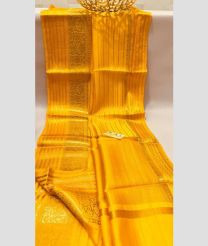
Georgette Saree
Georgette sarees are contemporary but very light in weight and easy to drape and come in several designs that suit the current trends in fashion.
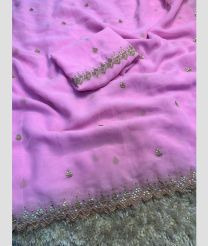
Why Choose Tapathi?
What really sets it apart is its authentic and distinctive quality, truly of work for which they have committed themselves. Their relationship with highly skilled artisans ensures every saree tells a tale of impeccable craftsmanship. With its rich collection from the latest handloom sarees, it holds something for almost every taste, making it rather easy for every woman to find that perfect one saree which speaks to her very own style.
Incorporating Handloom Sarees into Modern Wardrobes
A few of the occasions that one can celebrate with handloom sarees include:
Formal Events:
Go for awesome silk sarees like Kanchi Pattu or Banarasi sarees to flaunt.
Casual Outings:
For something really comfortable, linen or Chanderi sarees are perfect for being day-today.
Festivals:
Celebrate these occasions by a touch of those Pochampally Ikkat or Paithani sarees for a vibrant traditional look.
Office Wear:
Delicate uplines in Uppada or Gadwal sarees could team up for an office professional but gracefully chic look.
Caring for Your Handloom Sarees:
These are the golden rules for maintaining the beauty and life of your handloom sarees:
Cleaning:
Dry cleaning is advisable, especially in the case of cleaning silk sarees, whose brightness tends to dim.
Storage:
Store in a dry, safe place preferably wrapped in muslin fabric to prevent the color from fading.
Avoid Direct Sunlight:
Long durations keep fading the hues; air them in shades if necessitated.
Conclusion
Mostly handloom sarees are garments, but they are basically pieces of history. Now, as so many stores and brands have launched their collections of the latest handloom sarees, these beautiful, ageless pieces are no longer such a big task to put into anyone's wardrobe. Sarees have a lifetime grace, tradition, providing a very strong alternative fashion car parked across the lane, and they lead life-changing differences in artisan communities.
0 notes
Text
How Can I Identify an Authentic Handloom Saree?
Handloom sarees are treasured for their exquisite craftsmanship, cultural significance, and unparalleled beauty. However, with the growing demand for these timeless pieces, the market is flooded with machine-made imitations that often mimic the look of genuine handloom sarees. For saree enthusiasts, it is essential to recognize authentic handloom sarees to appreciate their value and support the artisans who create them. Here’s a guide to help you identify a genuine handloom saree.

1. Check the Weave
The hallmark of a handloom saree lies in its weave. Authentic handloom sarees are crafted manually on a loom, resulting in slight irregularities in the weave. These imperfections, such as uneven thread density or minor variations in patterns, are not flaws but proof of handmade artistry. In contrast, machine-made sarees are uniformly woven, lacking the unique character of handloom fabrics.
To verify the authenticity, flip the saree over and examine the reverse side. Handloom sarees often display intricate weaves on both sides, with no loose threads hanging from the back—a telltale sign of genuine craftsmanship.
2. Feel the Texture
Handloom sarees are typically made from natural fibers like silk, cotton, or blends of both. Their texture is soft, breathable, and luxurious. When you touch an authentic handloom saree, you can feel the richness and individuality of the fabric.
Machine-made sarees, often produced using synthetic materials, may feel stiffer and lack the warmth of handwoven textiles. The quality of the fabric in a handloom saree also improves with age, gaining a unique softness that machine-made sarees cannot replicate.
3. Examine the Borders and Pallus
One of the standout features of handloom sarees is their intricately designed borders and pallus (the loose end of the saree). In an authentic handloom saree, the borders are neatly woven and aligned with the body of the saree. The designs on the pallu are usually elaborate and seamlessly integrated into the weave.
Machine-made sarees often have printed or embroidered designs that may appear flat or less detailed compared to the woven patterns of handloom sarees. Carefully inspecting the borders and pallu can reveal whether the saree is handwoven or mass-produced.
4. Look for the GI Tag
Several types of handloom sarees, such as Banarasi, Kanjeevaram, and Pochampally Ikat, are protected by Geographical Indication (GI) tags. This certification ensures that the saree is made using traditional methods in the region of its origin. Checking for a GI tag is a reliable way to confirm the authenticity of certain handloom sarees.
5. Perform the Thread Test
Authentic handloom sarees are woven using high-quality, durable threads. To check the strength of the fabric, you can gently tug at a small section. Handwoven fabrics are tightly constructed and do not tear easily, whereas machine-made sarees may feel fragile or poorly constructed.
6. Observe the Color and Dyes
Handloom sarees are often dyed using natural or eco-friendly dyes, resulting in rich, vibrant colors that have a depth unmatched by synthetic dyes. The colors in a genuine handloom saree may have slight variations, which enhance their charm. Machine-made sarees, on the other hand, often use synthetic dyes that can appear overly uniform and may fade quickly.
7. Seek Transparency in Sourcing
When buying a handloom saree, choose trusted sellers or platforms that are committed to authenticity. Many reliable retailers provide details about the saree's origin, weaving process, and materials used. Additionally, some handloom sarees come with a handloom mark, issued by the Indian government, which certifies their authenticity.
8. Price as an Indicator
While price alone is not a definitive indicator, authentic handloom sarees often cost more due to the time, effort, and skill involved in their creation. If a saree is being sold at an unusually low price, it is worth questioning its authenticity. Investing in handloom sarees is about appreciating the artistry and supporting the livelihood of artisans.
Conclusion
Identifying an authentic handloom saree requires attention to detail and an understanding of its unique features. From the weave and texture to the craftsmanship and certifications, every element reflects the time-honored traditions of handloom weaving. By choosing genuine handloom sarees, you celebrate Indian culture and contribute to the preservation of this rich heritage. For a seamless and reliable shopping experience, explore Chhunchi, your one-stop online store for saree enthusiasts. With a commitment to authenticity and quality, Chhunchi brings the timeless charm of handloom sarees right to your doorstep.
1 note
·
View note
Text
Styling Handloom Sarees for Modern Occasions
Handloom sarees have transcended time, continuing to be a symbol of grace and elegance in modern fashion. iTokri offers a diverse range of handloom sarees, each with its unique charm and cultural significance.

Here’s how you can style these exquisite sarees for contemporary occasions:
Pochampally Ikat Sarees
Pochampally Ikat sarees are known for their vibrant colours and geometric patterns. For a modern look, drape a Pochampally Ikat saree with a contrasting blouse.

Add a belt to cinch the waist and give a contemporary twist. Finish the look with jhumkas and bangles.
Kalamkari Print Sarees
Kalamkari sarees, featuring hand-painted or block-printed designs, are perfect for artistic gatherings or cultural events.

Style a Kalamkari Print saree with a solid-coloured blouse to highlight the intricate designs. Add a choker necklace and a few rings for a sophisticated look.
Mangalgiri Handloom Sarees
Mangalgiri sarees, with their fine cotton texture and simple elegance, are ideal for daytime events. Pair a Mangalgiri Handloom saree with a contrasting blouse and lightweight jewellery.

Keep the makeup minimal and opt for loose waves or a side braid to keep the look fresh and casual.
Bandhani or Bandhej Sarees
Bandhani sarees, famous for their tie-dye patterns, are vibrant and festive. Style a Bandhani saree with a matching or contrasting blouse. Add a maang tikka and heavy earrings for a traditional look.

A braided bun with fresh flowers will complete this festive ensemble.
Kantha Embroidery Sarees
Kantha sarees, adorned with intricate embroidery, are perfect for weddings and formal functions. Drape a Kantha Embroidery saree with a silk blouse to enhance its elegance.

Opt for gold jewellery and a classic updo to complement the rich embroidery.
Kalamkari Block Print Sarees
Kalamkari block print sarees offer a mix of traditional and contemporary appeal. Pair one with a chic blouse design and statement earrings.

Keep the makeup bold with a bright lip colour to make the outfit pop.
Sambalpuri Ikat Sarees
Sambalpuri sarees, with their intricate patterns and vibrant colours, are ideal for both formal and casual occasions.

Pair a Sambalpuri saree with a plain blouse and subtle jewellery. A sleek bun or a high ponytail will add a modern edge to this traditional attire.
Begumpuri Sarees
Begumpuri sarees, known for their simplicity and elegance, are perfect for workwear or semi-formal events.

Style a Begumpuri saree with a high-neck blouse and minimalistic jewellery. Opt for a side bun or straight hair to keep the look polished.
Nakshi Kantha Sarees
Nakshi Kantha sarees, with their delicate embroidery, are a statement in themselves. Pair a Nakshi Kantha saree with a blouse that has subtle embellishments. Add a pair of chandelier earrings and a clutch to complete the look. A soft, wavy hairstyle will enhance the overall elegance.

Styling handloom sarees for modern occasions is all about balancing traditional elegance with contemporary trends. Whether it's the vibrant hues of Bandhani or the intricate patterns of Ajrakh, each saree from iTokri brings a unique touch to your wardrobe.
Experiment with different blouse designs, accessories, and hairstyles to create looks that are both timeless and chic.
#Pochampally Ikat sarees#Kalamkari Print saree#Mangalgiri Handloom saree#Bandhani saree#Kantha Embroidery saree#Kalamkari block print sarees#Begumpuri saree#Nakshi Kantha sarees
0 notes
Text
Handloom Sarees Online: A Timeless Fashion Choice
Introduction
Handloom sarees represent the epitome of elegance, culture, and tradition. These beautiful garments, woven with intricate detail and care, have been a part of Indian heritage for centuries. But with the rise of online shopping, the way we purchase these exquisite sarees has evolved. So, let’s dive into the world of handloom sarees online and discover everything you need to know.
Understanding Handloom Sarees
What Makes a Saree 'Handloom'?
A handloom saree is woven manually using a hand-operated loom. Unlike power looms, which are automated, handloom weaving requires skill, patience, and artistry. Each saree tells a story, with every thread carefully placed to create stunning patterns and textures.
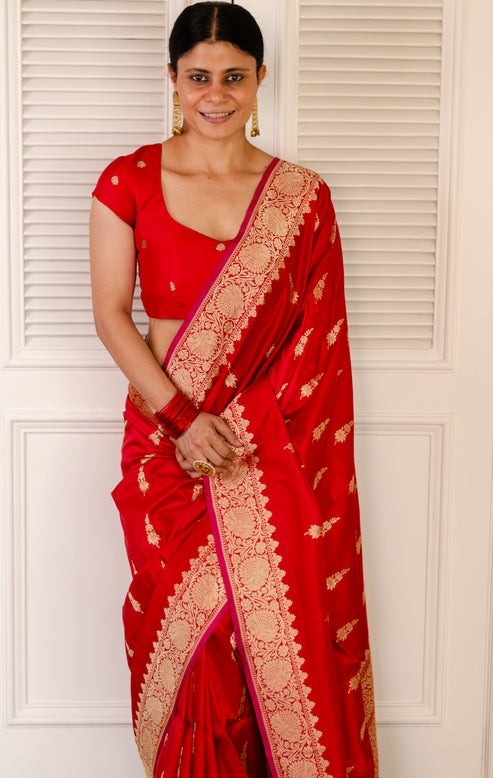
The Historical Significance of Handloom Sarees
Handloom sarees have a long history, spanning thousands of years. They were often worn by royalty and have been mentioned in ancient texts. The artistry involved in creating these sarees has been passed down through generations, preserving cultural traditions and craftsmanship.
Types of Handloom Sarees
Banarasi Sarees
Originating from Varanasi, these Banarasi sarees are known for their rich silk fabric and intricate brocade work. They are often adorned with gold and silver threads, making them a favorite for weddings and special occasions.
Kanjivaram Sarees
From Tamil Nadu, Kanjivaram sarees are celebrated for their vibrant colors and temple-inspired designs. They are made from pure mulberry silk and are a testament to South Indian craftsmanship.
Tussar Silk Sarees
Tussar silk, also known as 'wild silk', has a distinct texture and natural gold sheen. These sarees are lightweight and perfect for both casual and formal events.
Jamdani Sarees
A product of fine craftsmanship, Jamdani sarees from Bengal feature intricate patterns woven on the loom, often depicting flora and fauna. These sarees are popular for their lightness and clarity.
Chanderi Sarees
Chanderi sarees come from Madhya Pradesh and are made from a blend of silk and cotton. They are characterized by their sheer texture and glossy finish, often adorned with traditional motifs.
Pochampally Ikat Sarees
These sarees from Telangana are famous for their geometric patterns and vibrant colors, created through a unique dyeing technique called Ikat. Each saree is a masterpiece of precision and design.
The Craftsmanship Behind Handloom Sarees
Traditional Weaving Techniques
The weaving techniques used in creating handloom sarees are diverse and complex. Techniques like brocade, Ikat, and Jamdani require immense skill and attention to detail. These methods have been refined over centuries, ensuring that each saree is unique.
Benefits of Choosing Handloom Sarees
Unique Designs and Patterns
Each handloom saree is a piece of art, with no two sarees being exactly alike. The unique designs and patterns make them a standout choice for any wardrobe.
Eco-Friendly and Sustainable Fashion
Handloom sarees are often made using natural fibers and dyes, making them an eco-friendly choice. The manual weaving process also has a lower carbon footprint compared to industrial manufacturing.
Supporting Local Artisans and Communities
Buying handloom sarees directly supports local artisans and their communities. It helps sustain traditional crafts and provides a livelihood for many families.
Shopping for Handloom Sarees Online
Why Buy Handloom Sarees Online?
Online shopping offers a convenient way to access a wide variety of handloom sarees from different regions. It allows you to compare prices, read reviews, and find unique pieces that may not be available locally.
Tips for Buying Authentic Handloom Sarees Online
Research Reputable Sellers: Look for online platforms known for their authenticity and customer satisfaction.
Check Product Descriptions: Ensure the saree is labeled as 'handloom' and read the details about the fabric and weaving technique.
Look for Certifications: Some handloom sarees come with a Handloom Mark, which guarantees authenticity.
Recognizing Genuine Handloom Sarees
Genuine handloom sarees have certain characteristics:
Irregularities in the weave, which indicate handwork.
Soft, smooth texture with intricate details.
Higher price compared to machine-made sarees due to the craftsmanship involved.
Popular Online Platforms for Handloom Sarees
E-commerce Websites
Websites like Amazon and Flipkart offer a wide range of handloom sarees. They provide customer reviews and ratings, which can help in making informed decisions.
Artisan Marketplaces
Platforms like Gaatha and Itokri specialize in handmade and handloom products. They connect customers directly with artisans, ensuring authenticity and fair prices.
Social Media and Independent Stores
Many independent stores and artisans showcase their handloom sarees on social media platforms like Instagram and Facebook. These platforms offer a more personalized shopping experience.
Styling Handloom Sarees
Modern Ways to Drape Handloom Sarees
Experiment with different draping styles to give a contemporary twist to your saree. The butterfly style, lehenga style, or pant-style drape can add a modern flair.
Accessorizing Handloom Sarees for Various Occasions
Pair your handloom saree with statement jewelry, a chic clutch, and stylish footwear. For a traditional look, go for antique jewelry, while minimalistic accessories can give a modern touch.
Caring for Your Handloom Sarees
Washing and Storing Tips
Handloom sarees require gentle care. Hand wash with mild detergent or dry clean to maintain their color and texture. Store them in a cool, dry place, preferably wrapped in a muslin cloth.
Preserving the Quality of Handloom Fabrics
Avoid direct sunlight and moisture to prevent fading and damage. Iron them on low heat, and regularly air them out to keep them fresh and prevent mildew.
Conclusion
Handloom sarees are a timeless treasure that blend tradition with contemporary style. As online shopping continues to grow, it has become easier to find and purchase these exquisite sarees from the comfort of your home. Embrace the heritage and support the artisans by choosing handloom sarees for your next special occasion.
#Buy women clothes online#Handloom sarees#Handloom sarees online#Handloom and handmade dresses#ethnic online store#ethnic wear sarees online
0 notes
Text
Textile of Andhra Pradesh: Ikat, Pochampalli & Kalamkari

The Allure of Pochampalli Sarees
Pochampalli sarees from Andhra Pradesh are renowned for their elegant, muted color palettes and intricate designs. These pure cotton sarees, featuring traditional patterns in shades of yellow, blue, orange, and grey, pair beautifully with the multi-colored pearl jewelry popular in Hyderabad. Women who appreciate the timeless charm of handcrafted textiles find these sarees irresistible.
The Vibrant World of Kalamkari
The famous Kalamkari sarees from Andhra Pradesh are highly sought after for their vibrant, vegetable-dyed colors and intricate, all-over patterns created using a pen-like tool called a "kalam". These captivating sarees have become a craze among fashion-conscious women in major cities like Delhi, Mumbai, and Kolkata.
The Iconic Ikat Weaving Tradition
Andhra Pradesh is also celebrated for its Ikat weaving, a unique technique that produces striking geometric patterns. The Ikat sarees and fabrics woven in places like Puttapakka, Pochampalli, and Chautupal have gained global recognition for their artistry and craftsmanship.
Diverse Handloom Saree Offerings
In addition to the renowned Pochampalli and Kalamkari sarees, Andhra Pradesh is known for a variety of other handloom textiles, including the fine, lightweight Mangalagiri sarees and the intricate block print sarees that gained popularity during Indira Gandhi's time as Prime Minister. These sarees are highly prized by senior politicians, bureaucrats' wives, and fashion enthusiasts for their timeless elegance and exceptional craftsmanship.
The Enduring Appeal of South Indian Sarees
Across Andhra Pradesh and much of South India, women have a strong preference for wearing either pure cotton or pure silk sarees, depending on the occasion. Senior lady politicians, bureaucrats' wives, and officers often choose cotton sarees for summer and silk sarees for winter, showcasing their appreciation for the comfort and quality of these traditional textiles. In the ever-evolving world of Indian fashion, the textile traditions of Andhra Pradesh continue to captivate and inspire, offering a rich tapestry of vibrant colors, intricate designs, and timeless elegance.
#Andhra Pradesh textiles#Pochampalli sarees#Kalamkari sarees#Ikat weaving#handloom sarees#natural dyes#Indian fashion#traditional crafts#Hyderabad pearls#Mangalagiri sarees#block print sarees
0 notes
Text
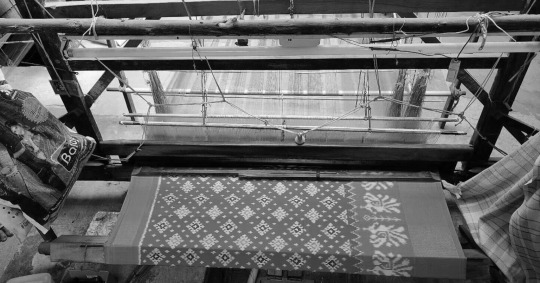
Navigating Through Warp & Weft

In this picture is Mr. Narasimha and his weaving machine, called Maggam in Telugu. I had met him on my visit to the town of Pochampally, situated around 50kms from Hyderabad. It is known as the Silk City of India because of the gorgeous sarees woven in a distinctive design known as Ikat. Mr. Narasimha is a handloom weaver of Pochampally silk sarees, mastering this for the last 25 years and his family has been doing this for generations. Usually, it takes four days to weave a single saree while working on it for 6-7 hours each day: One person can only complete seven sarees per month. There are around 1600-1700 people who are into weaving these sarees in this town and most of them belong to a caste called Padmasaleelu.
Initially, this used to be a cottage industry, and all of them had the Maggam Machines inside their homes. Slowly, as the business declined, it became difficult for individual weavers to survive on their own & they became contractual labour in the hands of Master weavers. One of the reasons for this shift from a self-owned cottage industry to becoming contractual labour in the hands of a proprietor, is lack of working capital & the issue of Loan waiver. There is a scheme solely dedicated to the weavers called Weavers MUDRA Scheme. Under this scheme, the weavers can borrow money to fund their working capital. A few years ago, the government of Telangana had announced that they would waive off the loans for weavers. The likes of Mr. Narasimha were encouraged by the local elected representatives to not pay the loan and wait for the waiver. This waiver took around three years to concretize, and even then, only 20%-30% of the principal amount was waived off. Finally, it has led to a decrease in their credit scores, and the banks are now refusing them to give loans. Due to this, they have no option other than working for the proprietors.
As I ask Mr. Narasimha about the weaver community’s issues, he shares that one of the most significant issues is the volatile input cost, especially the silk thread. The thread is ordered from Bangalore, and some of it is imported from China. Due to COVID, the imports from China have decreased in the last two years, and due to less rainfall, domestic silk production has taken a hit. Also, Mr. Narasimha hints at forming a syndicate in Bangalore where this silk thread is being bought at a slightly higher price by the power loom companies to produce silk curtains. These are then exported to European markets. All of these reasons together, have led to the rise in input costs of the saree. As I nudge him towards inquiring what could be done by the government to ease their troubles, he hesitates, and his colleagues chip in with their suggestions. They ask for a minimum amount to be fixed on sarees so that the market forces don’t exploit them. They also want a higher subsidy on the input of nearly 20%; currently, the input subsidy stands at around 10%, but it’s only for the cooperatives. Finally, they want the process of direct procurement by the government to be made more efficient. There is a massive delay in the payments by the government to weavers, so most of them prefer to sell their products to private buyers even for a lower price.
While going towards the Pochampally, I came across a power loom industry in the outskirts, and I asked Mr. Narasimha if these power looms affect their business. He proudly says that this is one thing the technology or the power looms cannot snatch away from them. The intricate design of these Ikat sarees mandate a human touch. The power looms can only produce plain and straightforward products, mainly curtains. During the interaction with Mr. Narasimha and his fellow weavers, I also realized that this was more art for them than just an occupation. It’s a skill that is being passed on to them from generations. It isn’t just about money; it’s more of a cultural thing. To move away from this generational occupation is to lose their identity and existence.
As we moved towards the end of our conversation, I gathered the courage to ask my naïve question about why this Pochampally Ikat only has to be a saree. Why could it not be a shirt, and maybe it could be marketed as a new thing in the market? With a wry smile on his face Mr. Narasimha very patiently answered that if a shirt were to be made, each one piece would cost more than Rs. 5000, and he said to me, “Would you buy one at that cost?”
0 notes
Text
Discover the Hottest Trends at SareeSaga's Online Store!
Sareesaga welcomes you to a vibrant world of tradition, elegance, and timeless style. We are your one-stop destination for exquisite online saree store, offering a treasure trove of designs, fabrics, and colors to cater to every woman's unique sense of fashion.
Why Choose Sareesaga?
Unmatched Selection: We boast a curated collection of sarees unlike any other. From classic handloom wonders to contemporary designer pieces, we have sarees for every occasion and every mood. Explore our diverse range of:
Silk Sarees: Immerse yourself in the luxurious world of Kanjivaram, Banarasi, Pochampally, and more, woven with intricate zari work and boasting unparalleled craftsmanship.
Cotton Sarees: Discover the comfort and elegance of Bengal Cottons, Maheshwaris, and Dhakai sarees, perfect for everyday wear or a casual soiree.
Designer Sarees: Make a statement with our trendy designer sarees, featuring bold prints, captivating embellishments, and contemporary silhouettes.
Lehenga Sarees: Channel your inner royalty with our stunning lehenga sarees, ideal for festive occasions and grand celebrations.
Bridal Sarees: Find the saree of your dreams for your special day. We offer a breathtaking selection of bridal sarees crafted with meticulous detail and exquisite embellishments.

Superior Quality: We are committed to providing you with sarees that are not only beautiful but also crafted with the finest materials and exceptional workmanship.
Unbeatable Prices: We offer sarees to suit every budget, ensuring that you can find the perfect piece without compromising on quality or style.
Hassle-free Shopping Experience: Enjoy a seamless shopping experience with our user-friendly website, secure payment gateways, and efficient delivery services.
Easy Return Policy: We understand that buying clothes online can be a concern. That's why we offer a hassle-free return policy for your peace of mind.
Explore Sareesaga by Occasion:
Finding the perfect saree can be overwhelming. To simplify your search, we have categorized our collection based on the occasion:
Wedding Sarees: Find the saree that will make you a radiant bride. Our wedding saree collection features a kaleidoscope of colors, rich fabrics, and mesmerizing embellishments.
Festival Sarees: Celebrate traditions in style with our vibrant collection of festival sarees. Dazzle in silks, dazzle in prints, or embrace the charm of bandhani and leheriya.
Party Sarees: Make a head-turning entrance at any party with our glamorous selection of party sarees. Shimmer in sequins, embrace bold prints, or exude elegance in designer drapes.
Work Sarees: Add a touch of sophistication to your work wardrobe with our collection of elegant and comfortable work online saree store. Explore a range of fabrics and styles perfect for the modern office woman.
Casual Sarees: Embrace effortless style with our collection of casual sarees. Discover lightweight fabrics, soothing colors, and comfortable drapes for everyday wear.

Beyond the Saree:
Sareesaga complements your saree experience with a curated selection of:
Blouses: Find the perfect match for your saree with our exquisite collection of readymade blouses or customize your look by tailoring them to your style.
Petticoats: Ensure a flawless drape with our comfortable and supportive petticoats available in various lengths and styles.
Jewelry: Elevate your saree look with our stunning collection of traditional and contemporary jewelry sets.
The Sareesaga Difference:
At Sareesaga, we are passionate about sarees and the rich cultural heritage they represent. We are committed to providing you with:
Authenticity: We source our sarees directly from weavers and artisans across India, ensuring the authenticity and ethical production of each piece.
Expert Guidance: Our customer service team is here to assist you in finding the perfect saree for your needs. We offer expert advice on fabrics, styles, and drapes to ensure you make an informed choice.
Celebration of Craftsmanship: We are dedicated to promoting the artistry and skill of Indian weavers by curating a collection that showcases the beauty of traditional techniques.
Shop Sareesaga Today!
We invite you to explore the Sareesaga difference. Immerse yourself in our world of exquisite sarees, discover the perfect piece to express your unique style, and celebrate the timeless elegance of the saree.
Visit our website today and embark on a journey of discovery. Browse our extensive collection, discover the saree that speaks to your heart, and experience the joy of online saree shopping with Sareesaga.
0 notes
Text
Draped in Tradition: The Enduring Allure of Chiniya Silk Sarees
Introduction:
The allure and timeless elegance of Sarees are incomparable, deeply ingrained in the hearts of Indians. The diverse wardrobe of Indian women is a tapestry woven with countless stories told by each saree.
Sarees effortlessly transcend occasions, seamlessly blending into both Western parties and traditional Indian festivals. The grace of a well-draped saree never fades.
Our rich traditional heritage offers a plethora of fabrics to tailor perfect outfits. The world of Silk Sarees in India is vast, encompassing various materials, intricate embroideries, diverse styles, and the fascinating stories behind the weaving process. chiniya silk saree proudly presents a wide range of Sarees, each with unique fabrics, prints, and more.

Now Let’s Know the Origin of Chiniya Silk
The origin of Pure Chiniya silk saree comes from Banaras. In earlier times, it was made using only natural white. Due to the severe effects of the Industrial Revolution in England, Indian textiles were greatly affected. Therefore, Banarasi weavers started working on a different type of silk thread and produced Chiniya silk.
banarasi chiniya silk saree, also known as Chiniya silk, is a unique and fine type of silk that holds a special place in the rich tapestry of Indian textile history. Originating from the state of Karnataka in India, particularly in the town of Chinniyampalayam, Original Chiniya silk has become synonymous with luxury and traditional craftsmanship.
Origins and Weaving Technique:

Cultural Significance:
Chiniya silk saree designs has deep cultural roots and is often associated with special occasions and festivals. The traditional Chiniya silk Sarees are known for their vibrant colors, intricate patterns, and the use of gold and silver zari work, adding opulence to the fabric. These Sarees have become a symbol of grace and timeless beauty, making them a popular choice for weddings and other significant celebrations.
Evolution in Design:
Over the years, Vintage chiniya silk saree has evolved to incorporate modern design elements while maintaining its traditional essence. Contemporary Chiniya silk Sarees often feature a blend of classic motifs and innovative patterns, attracting a broader range of consumers. The weaving communities have embraced technology to enhance their craftsmanship, resulting in a fusion of tradition and modernity.
Chiniya Silk Today:
Even today, the Best Chiniya silk saree for weddings remains a highly sought-after choice for those who appreciate the artistry and heritage of Indian textiles. Designers and weavers strive to preserve the authenticity of Chiniya silk while adapting to changing fashion trends. The Sarees are not only a wardrobe staple for special occasions but also a representation of cultural identity and craftsmanship.
Samyakk’s Contribution:
Samyakk.com, a renowned fashion destination, has played a significant role in promoting and preserving the legacy of Chiniya silk Sarees. By curating a diverse collection that blends traditional aesthetics with modern design, Samyakk.com ensures that Chiniya silk Collections remain a timeless and cherished choice for discerning customers.

Y Choose Samyakk for Chiniya Silk Saree
Step into a world of timeless elegance and affordability as we explore the captivating charm of Printed Chiniya Silk Sarees and the Silk Printed Sarees Collection at Samyakk Collections Online Shopping. From the regal grace of pure Chiniya silk to the budget-friendly allure of silk, this collection promises to redefine your wardrobe with style and sophistication.
Adorned with a light, soft, and flowing texture, Chiniya Silk Sarees are the epitome of elegance. Woven with delicate Chiniya silk yarn, these Sarees boast a unique silk thread that adds an extra layer of luxury. At Samyakk.com Collections Online Shopping, we curate a stunning collection of Chiniya silk saree blouse designs, featuring a variety of patterns that enhance the Saree aesthetic appeal.
For a modern and chic look, consider draping the Chiniya Silk Saree in a belt style, offering a contemporary twist to this traditional attire. The Saree versatility is further amplified with geometrical prints, adding a touch of class, while digital prints elevate its beauty to new heights.
Styling Tips:
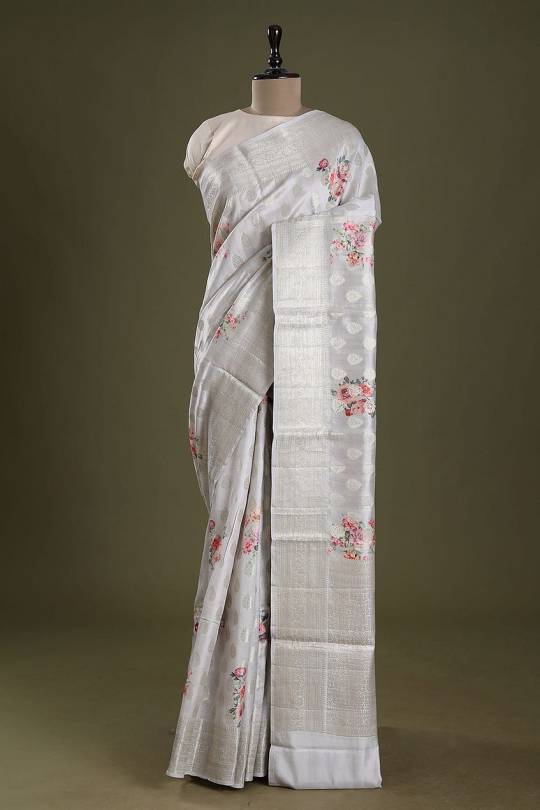
The intricate patterns add a perfect touch, with geometrical prints lending a classy allure and digital prints enhancing the Saree beauty. For weddings, adorn the Chiniya silk saree with a stunning gold Kundan set, creating a regal ensemble. Opt for pearl jewelry to complement the saree grace for casual occasions, showcasing your perfect style. Explore Chiniya exclusive online collection of Chiniya Sarees and indulge in the epitome of elegance.”
Frequently Asked Questions (FAQs)
What is Chiniya silk, and how is it different from other silk varieties?
A: Chiniya silk is a unique type of silk that originates from Karnataka, India. What sets it apart is the use of a specific silk thread known as “Chiniya” in its production. This delicate thread is intricately woven into the fabric, contributing to the distinct texture and sheen that defines Chiniya silk. Unlike traditional silk, Chiniya silk is celebrated for its lightweight, soft, and flowing texture.
2. What makes Chiniya silk Sarees special for occasions like weddings and festivals?
A: Chiniya silk Sarees are highly sought after for special occasions due to their vibrant colors, intricate patterns, and the lavish use of gold and silver zari work. These Sarees carry a cultural significance and are often considered a symbol of grace and timeless beauty. The opulent designs and luxurious feel make Chiniya silk Sarees a popular choice for weddings and festive celebrations.
3. How has the design of Chiniya silk Sarees evolved over time?
A: While Chiniya silk Sarees have deep traditional roots, their design has evolved over the years to incorporate modern elements. Contemporary Chiniya silk Sarees often feature a blend of classic motifs and innovative patterns. Weavers and designers have embraced technology to enhance craftsmanship, resulting in a fusion of traditional aesthetics with modern design.
4. Are Chiniya silk Sarees suitable for casual wear, or are they reserved for special occasions?
A: Chiniya silk Sarees, with their versatility, are suitable for a range of occasions. While they are often chosen for weddings and festivals due to their luxurious appeal, the evolving design trends have made Chiniya silk Sarees more adaptable. Today, you can find Chiniya silk Sarees designed for casual wear, offering a perfect blend of comfort and style for everyday use.
5. How can I care for and maintain the beauty of my Chiniya silk saree?
A: Caring for Chiniya silk Sarees involves gentle handling to preserve their delicate texture and intricate designs. It is advisable to dry clean Chiniya silk Sarees to avoid damage. Store them in a cool and dry place, preferably wrapped in a muslin cloth, to prevent any color transfer or damage. Avoid exposing the saree to direct sunlight for extended periods to maintain its vibrancy.
Conclusion
Chiniya Silk Sarees stand as a timeless embodiment of elegance, weaving together traditional charm with contemporary allure. The intricate craftsmanship, light texture, and vibrant patterns make them a coveted choice for various occasions. As you embark on a journey to embrace the richness of Chiniya silk, let each saree be a celebration of heritage and style. Elevate your wardrobe with the regal opulence and sheer grace of Chiniya Silk Sarees, shop online at www.samyakk.com and visit our store at Bangalore City.
#Saree#sarees#saree online#online saree shopping#pattu saree#sarees for wedding#indain wedding sarees#wedding designer sarees#without border silk#chiniya silk sarees#chiniya silk sarees with price#chiniya pattu sarees#chiniya sarees#chiniya pattu sarees online#chiniya pattu sarees price#chiniya pattu sarees with price#chiniya silk sarees online#Chiniya Silk sarees#handloom saree#handloom cotton sarees#handloom saree online#handloom silk sarees#khadi handloom saree#pure katan silk banarasi handloom saree#pochampally ikat saree#handloom banarasi saree#handloom saree price#white handloom saree#handloom cotton silk sarees with price#handloom tussar silk saree price
0 notes
Text
A rich and luxurious pochampally Ikat handloom saree! Abstract Ikat designs make this a piece of modern art. A chic weave for the modern muse. Jacquard ikat designs form a beautiful pattern on this festive pochampally ikat saree. The pallu is a thick zari with temple highlights.
#mavurisarees#indianethnicwear#silk saree#silk sarees#kanchipuramsilksarees#kacnhipuram silk sarees#kanchipuramsarees#indiantradition#banarasisaree#ethnicelegance
0 notes
Text
SILK SAREE
WE SALE SILK SAREE IN ONLINE
Tanchoi Silk: Weaving technique which is a blend of silk from the two countries, India and China.
Garad Silk: Garad originates in West Bengal, and is distinguished by its red border and small paisley motifs. Silk fabric used to weave Garad sarees is produced by the silk yarns woven close together which imparts the fine texture.
Jamawar: Jamawar Silk is an adulterated form of Pashmina silk which contains a blend of cotton and wool. This is usually used in weaving shawls for the winters.
Matka Silk: A rough handloom silk fabric made from the waste Mulberry Silk without removing its gum (sericin) part, largely produced in Karnataka and Kashmir.
Banarasi/Benarasi Silk: A fine variant of silk evolving from the lands of Beneras or Varanasi, known for gold and silver work of brocade and zari on the fabric.
Mulberry Silk: Purest form of silk extracted from Silkworms, usually produced in yellow, white, or greenish yellow color.
Murshidabad Silk: Silk produced at the Silk Mecca of East India.
Bangalore Silk: Known for its simplicity and purity of Silk, Bangalore silk is produced in the silk farms of Bangalore.
Angora Silk: Known for tender texture, the Angora silk yarn is made up from the fur of meek Angora rabbit.
Silk Embroidery: Intricate patterns embroidered in silk on various fabrics.
Pochampally/Pochampalli Silk: Type of silk originating from the town of Boodhan Pochampally, located in Nalgonda district of Andhra Pradesh, popularly known as the silk city of India.
Mysore Silk Crepe: Woven from hard spun silk yarn and comes from the silk city of Mysore in Karnataka.
Sournachuri Silk: Originating from West Bengal, Sournachuri Silk has gold thread incorporated in the weave of silk, hence giving a rich shine to the fabric. It is also known as the illustrious sister of the Baluchari Silk saree.
Raw Silk: Raw Silk is the most natural form of delicate fibre of silk with no twist and is unprocessed form of silk that can be easily woven into different fabrics.
Kosa Silk: Comes from Chattisgarh, and is known for its soft texture and dull-brownish look, hence available in shades of gold pale, dark honey, cream, etc. Kosa is one kind of Tussar Silk.
Tussar Silk: Also known as Wild Silk, Tussar radiates gold sheen in its fabric and is exclusively produced in India.
Muga Silk: Produced only in Assam, Muga silk yarns are totally yellow in color and is considered as strongest natural fibre.
Eri Silk: Also known as Errandi and Endi in most parts of India, Eri Silk is the purest forms of silk from the east, with a dull yellow, gold like sheen.
Dharamavaram Silk: Known for gold-plated borders, Dharamavaram silk orginates from Andhra Pradesh, and is also known as Silk for the Bride.
Narayanpet Silk: Originates from Andhra Pradesh, the textiles of Narayanpet have a checked surface design with embroidery and the border or pallu have intricate ethnic designs such as a temple.
Pat/Paat Silk: Produced in Eastern India, Pat silk is known for its distinctive brightness, high quality and durable nature. It comes in brilliant white or off-white shades.
Cot Silk: A well-blended combination of cotton and silk, Cot silk is a cheaper-priced silk.
Kanchipuram: Silk from the village called Kanchipuram in Tamil Nadu, India, this one is known for its durability and shine. The rich quality combined with an amazing finish make them last longer.
Bhagalpuri Silk: Known as the Queen of all fabrics Bhagalpuri Silk originates from West Bengal and is very well known for its unique and striking resilience and superior quality.
Uppada Silk: Also known as Uppada Pattu (Silk in Telugu), Uppada silk comes from Andhra Pradesh. Usually woven in cotton warp, this one is known majorly by the length and breadth count of threads.
Art Silk: Short form for artificial silk, art silk is manufactured by a synthetic fiber like Rayon that very much resembles the silk fiber; however, costs a lot less on the front of manufacture and production.
0 notes
Text
Pochampally Silk Saree Price List: Find the Best Deals and Styles
Pochampally silk sarees hold a special place in the world of traditional Indian attire. Known for their unique geometric patterns, vibrant colors, and intricate ikat weaving, these sarees represent the rich heritage of Indian craftsmanship. Originating from the town of Pochampally in Telangana, they are cherished by saree enthusiasts for their timeless appeal and versatility. If you're looking to add one of these exquisite pieces to your wardrobe, understanding the Pochampally silk saree price range can help you find the best deals and styles to suit your preferences.

Why Are Pochampally Silk Sarees So Special?
The art of crafting Pochampally silk sarees lies in the ikat weaving technique, a process where threads are dyed before they are woven into the fabric. This complex method requires precision and skill, resulting in patterns that are vibrant and symmetrical. The sarees often feature bold geometric designs, floral motifs, and intricate borders, making them a favorite for both traditional and modern occasions.
Additionally, Pochampally silk sarees are made using high-quality silk, which adds a luxurious sheen and durability to the fabric. This combination of artistry and premium material makes these sarees a prized possession for anyone who values elegance and tradition.
Factors Influencing Pochampally Silk Saree Prices
The price of a Pochampally silk saree can vary widely based on several factors. Here's what you should consider before making a purchase:
Fabric Quality: The quality of silk used plays a significant role in determining the price. Sarees made from pure mulberry silk are more expensive compared to blends of silk and cotton. If you're looking for an authentic and luxurious feel, investing in pure silk is worth it.
Design Complexity: Intricate designs require more time and effort from skilled artisans, which increases the cost. Sarees with detailed patterns, heavy borders, or dual-tone effects tend to be on the higher end of the price spectrum.
Weaving Technique: Traditional handwoven sarees are more valuable than machine-made ones due to the labor-intensive process and unique craftsmanship involved. Handloom sarees are not only beautiful but also carry the essence of cultural heritage.
Occasion: Bridal and festive Pochampally silk sarees often feature heavy embellishments, zari work, or unique color combinations. These sarees are typically more expensive than those meant for casual or office wear.
Availability: The region where you purchase the saree can also influence its price. Buying directly from weavers or markets in Pochampally may offer better deals compared to purchasing from high-end stores.
Price Range of Pochampally Silk Sarees
The Pochampally silk saree price range is diverse, catering to various budgets:
Budget-Friendly Options (₹3,000 to ₹7,000): These sarees are often made from silk-cotton blends or feature simpler designs. They are perfect for casual events or light festive wear.
Mid-Range Sarees (₹7,000 to ₹15,000): Sarees in this range are usually made of pure silk with moderately intricate designs. They strike a balance between elegance and affordability, making them ideal for weddings, family gatherings, or traditional celebrations.
Luxury Range (₹15,000 and Above): Premium Pochampally silk sarees are crafted with pure silk, detailed patterns, and heavy zari work. These sarees are often custom-made and designed for grand occasions like weddings or festive ceremonies.
Tips to Find the Best Deals on Pochampally Silk Sarees
Shop During Festivals and Sales: Many sellers offer discounts during major Indian festivals like Diwali, Dussehra, or Sankranti. Keep an eye out for these deals to save on your purchase.
Explore Local Markets: Visiting local markets or weaving villages can help you find authentic sarees at competitive prices. By buying directly from artisans, you not only get a better deal but also support their craft.
Check for Authenticity: Ensure that the saree is made of genuine Pochampally silk by checking for quality certifications. Authentic sarees often come with a Geographical Indication (GI) tag, which guarantees their origin and craftsmanship.
Compare Prices: Take your time to compare prices across multiple sellers. While some might offer better rates, others may include additional benefits like free delivery or customization options.
Opt for Online Options Wisely: If you prefer online shopping, look for reputed sellers and read customer reviews to verify the authenticity of their products. Many platforms provide detailed descriptions and close-up images of sarees to help you make an informed choice.
Styling Your Pochampally Silk Saree
A Pochampally silk saree is a versatile piece that can be styled in multiple ways to suit different occasions:
For a traditional look, pair your saree with a classic blouse, gold jewelry, and a neatly tied bun adorned with flowers.
To create a modern twist, experiment with contrasting blouses, statement earrings, and an open hairstyle.
Use a belted drape for a contemporary edge, especially during receptions or parties.
Conclusion
Pochampally silk sarees are more than just garments; they are a celebration of India’s rich textile heritage. Whether you're attending a wedding, celebrating a festival, or simply adding to your saree collection, these sarees are a timeless choice. By understanding the factors that influence the Pochampally silk saree price and exploring different options, you can find the perfect saree that fits your budget and style.
Investing in a Pochampally silk saree is not just about owning a piece of clothing—it's about embracing a legacy of craftsmanship, culture, and elegance. So, start exploring and find the saree that resonates with your personality and occasion!
For more info :-
handloom sarees with price
mangalagiri pattu sarees with kanchi border
0 notes
Text
Exploring the Rich Heritage of Telangana: A Journey Through Time
Introduction:
Telangana, a vibrant state in southern India, boasts a rich and diverse heritage that spans thousands of years. From its ancient archaeological sites to its magnificent monuments, Telangana offers a fascinating journey through time. This article invites you to delve into the cultural tapestry of Telangana, exploring its historical treasures and the stories they hold.
The Archaeological Marvels:
Telangana is home to numerous archaeological sites that provide a glimpse into its ancient past. Explore the UNESCO World Heritage site of Warangal Fort, a majestic structure built during the Kakatiya dynasty. Discover the ruins of the ancient city of Golkonda, known for its impressive fortifications and the world-famous Koh-i-Noor diamond. Unearth the secrets of the thousand-pillar temple in Hanamkonda, a masterpiece of Kakatiya architecture.
The Glorious Kakatiya Dynasty:
The Kakatiya dynasty, which ruled Telangana from the 12th to the 14th century, left an indelible mark on the region's history and culture. Learn about their architectural brilliance, including the iconic Ramappa Temple, renowned for its intricate carvings and stunning sculptures. Dive into the stories of the Kakatiya rulers and their contributions to art, literature, and governance.
The Cultural Extravaganza:
Telangana's heritage extends beyond its architectural wonders. The state is known for its vibrant cultural traditions, celebrated through music, dance, and festivals. Explore the folk dances of Telangana, such as Perini Sivatandavam, Bathukamma, and Lambadi, which reflect the essence of the region. Immerse yourself in the melodious strains of Telangana's folk music, with its unique instruments and soul-stirring lyrics.
The Nizami Legacy:
Hyderabad, the capital city of Telangana, was once ruled by the Nizams, a dynasty known for their opulence and patronage of the arts. Discover the architectural marvels of Hyderabad, including the iconic Charminar and the grand Chowmahalla Palace. Experience the royal lifestyle by visiting Falaknuma Palace, now a luxurious heritage hotel that showcases the Nizami grandeur.
Telangana's Living Traditions:
While exploring Telangana's heritage, encounter its living traditions that have stood the test of time. Witness the age-old craft of Bidriware, known for its intricate silver inlay work on metalware. Explore the handloom clusters of Pochampally and Gadwal, where master weavers create exquisite silk and cotton sarees. Engage with the skilled artisans who continue to preserve and promote these traditional crafts.
Conclusion:
Telangana's rich heritage is a testament to its glorious past and the legacy of its rulers and communities. From awe-inspiring architectural wonders to vibrant cultural traditions, Telangana offers a captivating journey through time. By exploring its archaeological sites, experiencing its living traditions, and immersing oneself in its cultural tapestry, one can truly appreciate the depth and diversity of Telangana's heritage.
0 notes